Awesome! These 17 medical and home remedies may help you get rid of keloid scars!
If you are suffering from keloid scars you probably know how annoying this overgrown tissue might be. This article describes causes, signs and risk factors for keloids and features 17 medical and natural treatment options (with detailed instructions), which may help you get rid of keloids.
What are keloids?
A keloid is the formation of the scar which is mainly composed of different types of collagen depending on its maturity. It is actually the result of the overgrowth of scar tissue at the site of the healed tissue (1, 2, 8). Firstly, it is composed of type III collagen and then slowly changes to type I collagen. Keloids are firm and rubbery lesions and can vary from pink color of the patient’s skin to dark brown and even red in color. A keloid scar is generally harmless and isn’t contagious. However, it is sometimes accompanied by severe pain, itchiness and change of texture. It also affects the movement of skin in some severe cases. These scars are mainly found about 15 times more in the people of African descent as compared to those of European descent.
What are the causes of keloid scar formation?
The exact cause of Keloid isn’t yet known. It usually develops after acne spots and boils, burns, surgical wounds, body piercings and body lacerations. A cut from a trauma can also cause keloids. Infection also increases the overall risk. There is a problem with cells, known as fibroblasts, which are responsible for the production of scar tissues. It isn’t yet known whether there is a problem with fibroblasts themselves or there is a problem with the chemicals which control their activity. The collagen fibers are also thicker and wavier.
This leads to the thick and raised appearance which is a characteristic of a keloidal scar (2).
Here is a typical appearance of a keloid scar.
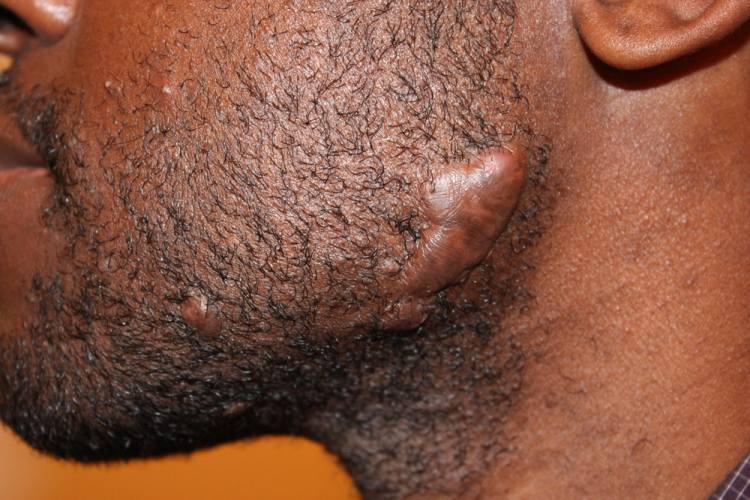
A keloid scar on face
The American Osteopathic College of Dermatology (AOCD) estimates that about 10 percent of people suffer from keloid scarring (3).
Both men and women are equally prone to it. However, people with dark pigmented skin, like the African Americans, are more prone to keloid scars.
Signs and symptoms of keloids
While keloid scars usually do not cause any pain or other symptoms, there are some signs indicating you may suffer from a keloid, such as:
- Appearance: First of all, they are firm, raised, smooth, and shiny. They are often red or pink in color and lighter or darker in color than the surrounding skin. They also always extend beyond the original wound, by many centimeters. They aren’t painful in general; however, they can be quite itchy at times.
- Location: Keloid are more likely to form on the back, arms, mid chest, neck and lower legs. They usually form as a wound heals and may take several months to years to develop. Sometimes, they continue to grow indefinitely. Once they stop growing, they either become a bit small or continue growing.
- Not generally harmful: Although the keloid scars are itchy; but they aren’t usually harmful to the health. You may feel tenderness, discomfort or irritation from clothing or other forms of friction. Sometimes, you may also experience keloid scarring on a significant part of your body. In this case, the hardened scar can seriously hamper your movements.
- Cosmetic issue: Keloids are generally more of a cosmetic concern than a health one. You may feel quite self-conscious if the keloid is on a visible location, like the face or on the earlobe. Sun exposure can tan the scar and make it a bit darker than the surrounding skin. This makes the keloid even more prominent. So, you should keep the keloid covered at all times.
- Keloid vs. hypertrophic scar: You should know here that keloids are a bit different from hypertrophic scars in the sense that they extend beyond the site of the injury and occur without causing any injury. Hypertrophic scars are more common than keloids and many people who think that they have keloids actually suffer from hypertrophic scarring. So you should always consult a doctor before trying out anything.
What are the risk factors for keloids?
If you already suffer from keloids, there are high chances that you would suffer from another one. The only exception is a single keloid on the ear lobe. Research has shown that following are the factors which increase the risk of keloids or their recurrence after treatment (4):
- Age and gender – Younger people are more prone to have keloids as compared to the elderly. This may be due to the way our body responds to the wounds as we age. A 2005 study showed that ear-piercing in children before the age of 11 increases the risk of keloids. The rate of occurrence of keloids is also higher in young girls as compared to boys.
- Certain drugs – There may be a link between the occurrence of keloids and using anabolic steroids. And the recurrence of keloid, is sometimes, due to the use of argon laser treatment and systematic retinoid during the previous treatment.
- Type of wound – The risk of keloid is also dependent on the type of wound. Generally, burn injuries are associated with a higher risk of recurrence as in infection.
- Heredity – Analysis of keloids has shown that keloids mostly run in families. Moreover, people born with genetic disorders like Opitz-Kaveggia syndrome, progeria, and Turner’s syndrome are also more prone to developing keloids.
Medical treatments for keloids
There are a number of medical treatments for keloids. These include the use of corticosteroids, laser therapy and compression therapy.
Here is a picture summarizing medical treatment options for keloid scars.
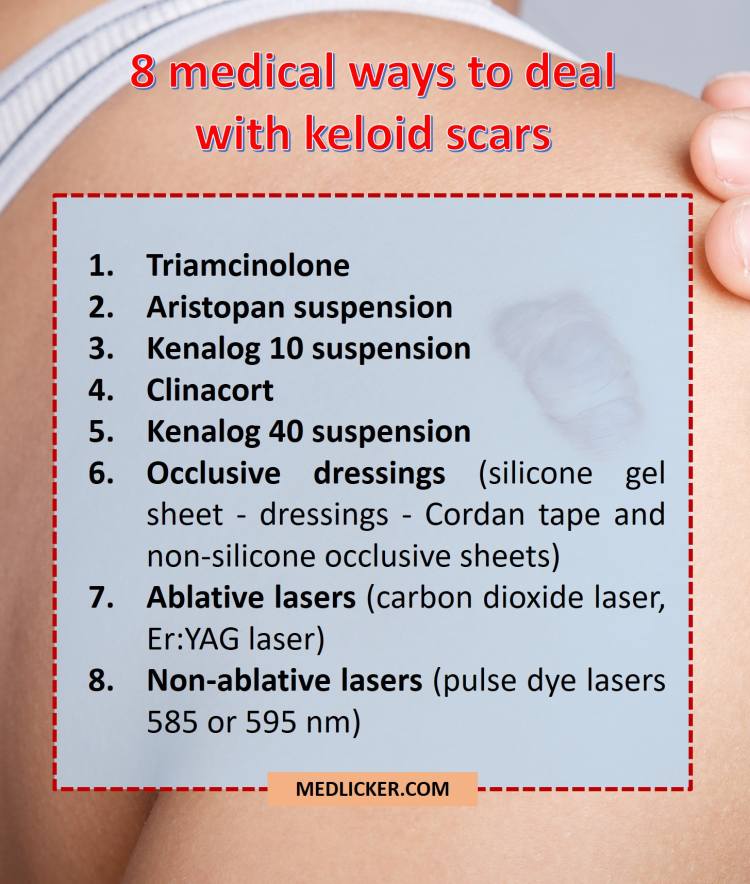
Medical treatment options for keloids (drugs and lasers)
All these treatments are described below:
Medications
There are a number of drugs used for the treatment of keloids (5, 6, 7, 8). Most of these drugs are corticosteroids. The top five of these drugs have been mentioned below:
1. Triamcinolone
Triamcinolone belongs to the class of drugs known as corticosteroids. It prevents the release of such substances in the body which cause inflammation. Triamcinolone oral is used for treating a number of skin conditions, including arthritis, lupus, allergic disorders, skin conditions or breathing disorders.
You shouldn’t, however, intake triamcinolone if you are suffering from a fungal infection anywhere in your body. You should also be careful because it is a steroid medication and steroid medications make it easier for one to get an infection. Steroids also worsen the infection you already have or an infection you had previously. You should also consult the doctor regarding whether you have had an infection in the past several weeks.
Take the drug exactly as prescribed by the doctor. Don’t take it in smaller or larger amounts than recommended. You should also follow the prescription labels carefully. You should also take the drug with food to prevent stomach upset.
2. Aristospan suspension
Aristospan is used to treat a number of disorders, like tendonitis, arthritis, keloids or bursitis. It can also be used for other conditions determined by your doctor. It is a corticosteroid, but as to how it exactly works to decrease swelling or irritation isn’t yet known. But it does relieve the discomfort caused due to inflammation.
You should not take aristospan if you are allergic to any ingredient in Aristospan suspension or you have an infection of some kind, like the herpes infection, fungal infection or malaria infection. You should also inform your pharmacist beforehand if you are pregnant or breastfeeding, you have allergies to foods, medicines or other substances, you are taking a prescription or non-prescription medication, you have joint surgery, liver problems or kidney problems.
Aristospan suspension is usually given in the form of an injection at the doctor’s office, hospital or clinic. If you are using aristo span at home, your healthcare provider will inform you how to use it. You should carefully understand the work of Aristospan suspension. Follow the exact procedures every time you take a dose.
3. Kenalog 10 suspension
Kenalog 10-Suspension is used for treating a number of different disorders, like arthritis, bursitis, keloids or tendonitis. It can also be used to treat many skin problems. It is widely used for its anti-inflammatory properties. It can also be used to treat other conditions as determined by your doctor.
You shouldn’t, however, intake this drug if you are allergic to any ingredient in Kenalog 10-suspension, you have a herpes infection in the eyes or you have a systematic malaria infection in the brain. There are also some medical conditions which may interact with Kenalog-10 suspension. So, be sure to tell your doctor, if you are pregnant or have plans on becoming pregnant, if you have allergies to food and medicines, if you have a bacterial or fungal infection, if you have diarrhea or if you have osteoporosis.
You should use Kenalog 10-suspension exactly as prescribed by the doctor. If you have a kenalog 10-suspension at home, your healthcare provider will give you instructions on how to use it. You should also follow the procedures taught to you clearly. In case you have any questions, consult your healthcare professional.
4. Clinacort
Clinacort is a steroid which prevents the release of inflammation-causing substances in the body. This drug is used in the injection form and is injected into the joint space to treat the joint or tendons inflammation. It is usually given as a short-term treatment for harsh skin conditions. The injection is injected into the soft tissues to treat the different skin disorders and treat autoimmune disorders caused by lupus and others.
You shouldn’t, however, take the drug if you are allergic to clinacort or any of the ingredients present in the drug. You should also inform the doctor if you have other conditions, like any type of bacterial or fungal infection, a thyroid disorder, stomach or intestinal ulcer, a muscle disorder or have recently had a heart attack.
This medication is injected into the joints or soft tissues. You will receive the injection in a hospital setting or clinic.
5. Kenalog 40 suspension
Kenalog-40 suspension is used to treat inflammation in a number of different disorders. This drug is actually a glucocorticoid with anti-inflammatory action. It can also be used to treat skin problems, asthma, chronic pain and allergic reactions.
You should, however, avoid Kenalog-40 suspension if you have an active herpes infection in the eyes, a fungal or malarial infection in the brain or you are allergic to any ingredient in Kenalog-40 suspension.
The drug is usually given in the injection form. A healthcare provider will administer the injection in a hospital setting.
Occlusive dressings
Occlusive dressings usually include silicone gel sheet and dressings, cordan tape and nonsilicone occlusive sheets. These measures have been quite successful (9, 10). The antikeloidal effects are caused by a result of combination of occlusion and hydration rather from the effect of silicone.
Some previous studies in patients treated with silicone occlusive sheeting with pressure of 24 h/d for about 12 months, have shown about 34% showed excellent improvement, 34.5% showed average improvement and 28% showed slight or no improvement at all. On the other hand, patients treated with semiocclusive, semipermeable occlusive dressings for about 8 weeks experienced 60% flattening of keloids, 78% reduction in tenderness, 71% reduced pain, 80% reduced pruritus and 90% were quite happy with the treatment (11, 12, 13, 14, 19).
Sometimes, cordan tape is also used which contains a steroid known as flurandrenolide, which has shown to soften and flatten the keloids with the passage of time (15).
Laser therapy
1. Ablative lasers
The use of ablative lasers includes the ablation of keloids using a carbon dioxide laser which can cut and cauterize the lesion which creates a dry environment with minimal tissue trauma. When used alone, the carbon dioxide laser had recurrence rates of 39-92% and when it was combined with injected steroids, the recurrence rates were about 25-74% (16, 20).
A Korean study was done recently which included about 30 patients with hypertrophic scars with 3 different modalities: copper bromide laser (CPL), 10600-nm ablative carbon dioxide laser (AFL), and intralesional TAC. The end result of the study showed that CPL got better results for pigmentation and vascularity. AFL and AFL plus TAC were also quite effective, especially with regards to the thickness. AFL produced epidermal resurfacing. The researchers concluded by saying that the combination of CBL, AFL and TAC can provide a new treatment option for hypertrophic scars (17).
Er: YAG laser (YAG stands for Yttrium Aluminium Garnet laser) is also quite effective for the treatment of keloids and it showed a 51.3% decrease in redness, 48% decrease in hardness of keloids and 50% decrease in elevation in one study. However, the recurrence rate wasn’t reported. Similarly, the argon 488-nm laser can induce collagen shrinkage. The argon laser had a recurrence rate of 45-93% (18).
2. Non-ablative lasers
a. Pulse dye laser 585-nm:
The 585-nm pulse dry laser (PDL) is a good treatment for keloids and results in microvascular thrombosis. The treatment started in 1985 and the researchers noted that the scars became more pliable and less hypertrophic after treatment with 585-nm PDL. The findings were confirmed later by using measurements of erythema by reflective spectrometry readings and scar height. It is quite safe and relatively low in cost, so PDL 585-nm remains a good choice for the treatment of keloids and hypertrophic scars.
A randomized clinical study was done in which the researchers treated 10 keloidal or hypertrophic scars with a 585-nm flash pumped PDL at 3, 5 and 7 J/cm2 and one segment was left as a control group. The treatment group consistently showed better results than the control group. A trend was obtained which was that the lower fluences had more benefits. Multiple sessions led to better improvement (21).
b. Pulse dye laser 595-nm:
PDL 595-nm is also quite effective for treating keloids. In fact, there are two studies which indicate that 585-nm PDL has more stains as compared to 595-nm PDL. The studies showed that the beneficial effects of lasers inhibiting scar tissues increased when the wavelength increased from 585 to 600 nm. However, more studies are required to obtain similar conclusion for human tissues. Longer wavelength is also an alternative for vascular-specific laser for dark-skinned patients.
Currently, the 595-nm PDL systems have a handpiece of the cryogen spray cooling device which allows the safe and effective treatment of hypertrophic scars by increasing the threshold for epidermal damage, which avoids the resultant epidermal necrosis when the temperature exceeds 70 degrees after exposure to PDL.
Home remedies for keloids
In addition to medical treatment options above you may get a keloid relief by using some natural home made remedies. While some patients may benefit from these therapies, there are no clinical trials and studies with supporting evidence. This means that sometimes you may see no results at all while sometimes these remedies actually help.
You should also know that use of these alternative treatments for keloid scars may be associated with some risks and precautions. Therefore you should always ask your licensed physician for approval before taking or using any of the natural remedies below.
The picture below summarizes 15 most popular natural remedies for keloids.
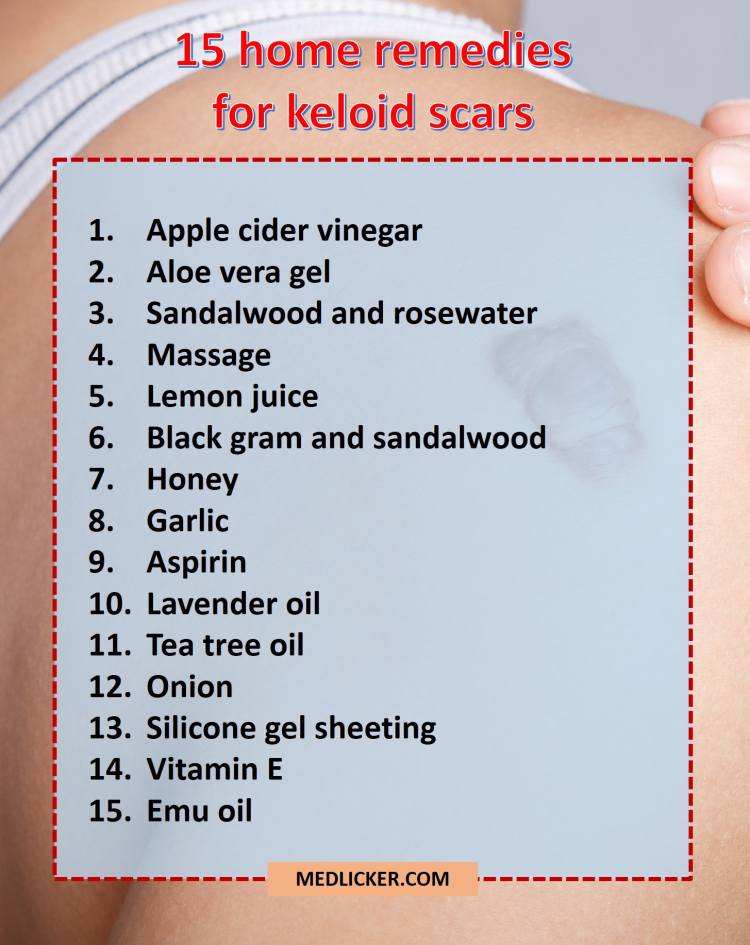
Fifteen natural home remedies for keloids
And here is a detailed description of each remedy, including detailed instructions on how to use it to deal with keloid scars:
Apple cider vinegar
There isn’t a home remedy which is complete without apple cider vinegar. It is particularly effective in the treatment of keloids because it minimizes the redness and even the size of keloids.
Directions
Using apple cider vinegar for treating keloids is quite easy. First of all, take apple cider vinegar and apply it directly on the scar.
Gently massage the area, so that the apple cider vinegar becomes fully covered by the scar.
Allow the apple cider vinegar to dry out.
Now once it has dried, repeat the process.
You should do this process twice a day.
Aloe vera gel
Although aloe vera gel is mainly used for hair loss, it is also an effective treatment in getting rid of keloids. In fact, aloe vera is quite widely used in the field of cosmetology (22). It is also quite helpful in revitalizing and helps in skin regeneration. It also diminishes the scars and so, people with keloid problems should definitely use it.
Directions
To use aloe vera gel on keloids, first of all, wash the affected area to make sure it is free from dirt and bacteria.
Now apply aloe vera gel on it to make the healing faster.
Allow the gel to remain on the scar for several hours.
You should also reapply it whenever necessary.
Sandalwood and rosewater
Sandalwood has regenerating properties and rose water acts as a natural toning agent and the combination of both sandalwood and rose water makes for an effective treatment for keloids.
Directions
To apply sandalwood, take sandalwood powder and add enough rosewater to make a paste.
Mix it well and apply on the scar. Let it remain for an entire day with frequent reapplication to avoid getting dirt in the area.
At night, put on a fresh coating and let it remain overnight. This will prevent and reduce the keloid scars.
The keloid scars will reduce in appearance after several months of treatment.
Massage
Well, there is quite a simple way of getting rid of keloids. All you need to do is to massage the area where the keloid is forming. There will be times when the scars will form because of lack of blood circulation.
Massaging the scarred area can remove the dead skin cells. This can help in preventing keloids from growing on certain areas of skin.
You should always use coconut oil for massage. You can either massage the affected area by yourself or ask a healthcare professional to do it for you. You should do it often. It won’t only relax the skin but prevent the formation of keloids.
Lemon juice
You can also use lemon juice to prevent keloids. The great thing about lemon juice is that it has a lot of properties which prevent the formation of keloids.
The main reason behind this is the presence of vitamin C in it which keeps the skin healthy.
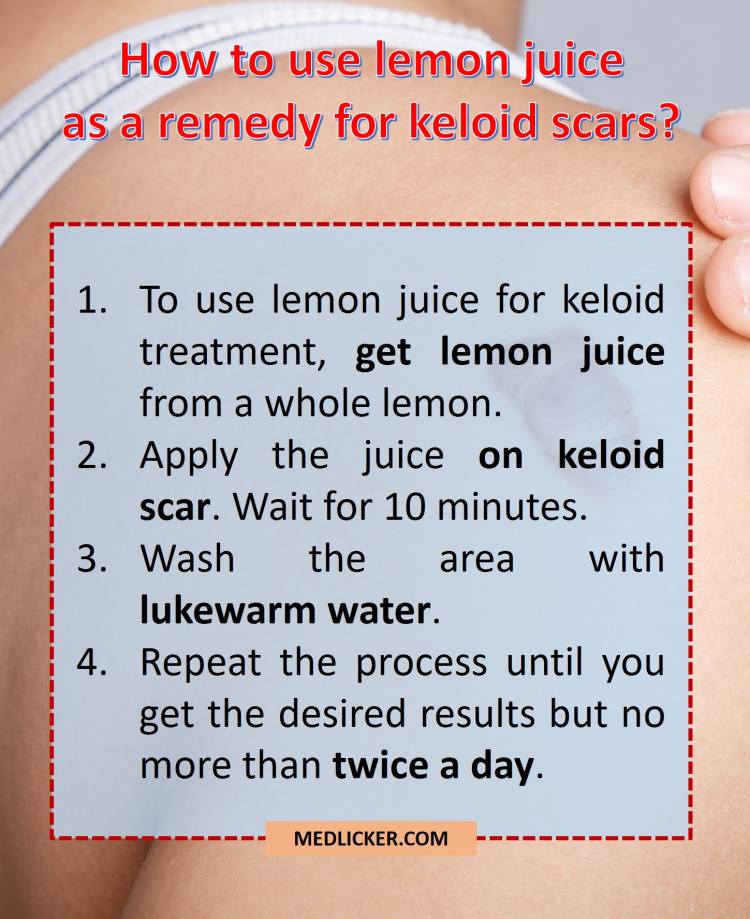
How to use lemon juice as a remedy for keloids?
It has also antioxidant properties which prevent the formation of keloids in the first place.
Directions
To use lemon juice for keloid treatment, get lemon juice from a whole lemon.
Now apply the juice in the area of the scar and wait for 10 minutes.
Wash the area with lukewarm water.
Repeat the process until you get the desired results but no more than twice a day.
Black gram and sandalwood
Black gram is another beneficial remedy for scar treatment because it helps in lightening the scar which makes it even lighter than the surrounding skin tone.
Directions
You just have to mix black gram with sandalwood powder and make it into a paste along with water.
Now apply it on the keloid area and leave it for the entire morning or overnight.
The keloid scars will be visibly reduced after several months of treatment.
This treatment is quite beneficial if you use it on the onset of keloids because keloids have the tendency to harden and break down with the passage of time.
Honey
Honey heals and moisturizes the skin and is popularly known as a wonderful humectant. It also has amazing antibacterial properties which avoids the recurrence of keloids and other scars.
Directions
You should just take the fresh honey and apply it to the keloid area every day.
Dryness can cause the keloids to become deeper and more prominent, however, honey prevents the skin dryness and keeps it soft.
You should massage the area gently after applying honey because it will promote blood circulation and prevent the growth of excess collagen and dead cells accumulation.
Garlic
Garlic is also quite beneficial against keloids because it prevents the fibroblast proliferation which can lead to the formation of keloids (23). This makes it a good treatment for keloids and hypertrophic scars.
Directions
To use garlic for the treatment of keloids, apply garlic oil directly on the scar.
Now leave it for 10 minutes and then wash the area thoroughly.
In case garlic oil isn’t available, you can always use crushed garlic cloves.
If the garlic oil or crushed garlic cloves cause irritation, wash the area with lukewarm water immediately.
Aspirin
While this isn’t a direct home remedy, you have got to admit that everybody has some aspirin lying in their refrigerator door. Many reviews have supported that it is an effective remedy for keloid scar treatment, so you should definitely take it into consideration.
Directions
To use aspirin for keloid treatment, crush a few aspirins and crush the powder you have obtained with water until you get a paste.
Now apply it to the affected area and allow it to dry on its own.
If you are consistent and apply the paste every day, you would see promising results quickly.
Lavender oil
You should make using lavender oil for treating keloid scars as a priority. The wonderful thing about lavender oil is that it doesn’t only help in treating scars but also prevents them from reappearing again.
Directions
You can apply lavender oil by massaging it on the affected skin and repeating the process as many times as you like.
Whatever you do, just keep in mind of using this remedy daily for several months.
It might seem a lot, but you will have great end results.
Tea tree oil
Aside from lavender oil, there are a few other oils quite beneficial in treating keloid scars. One such oil is tea tree oil, thanks to its remarkable antiseptic properties (24).
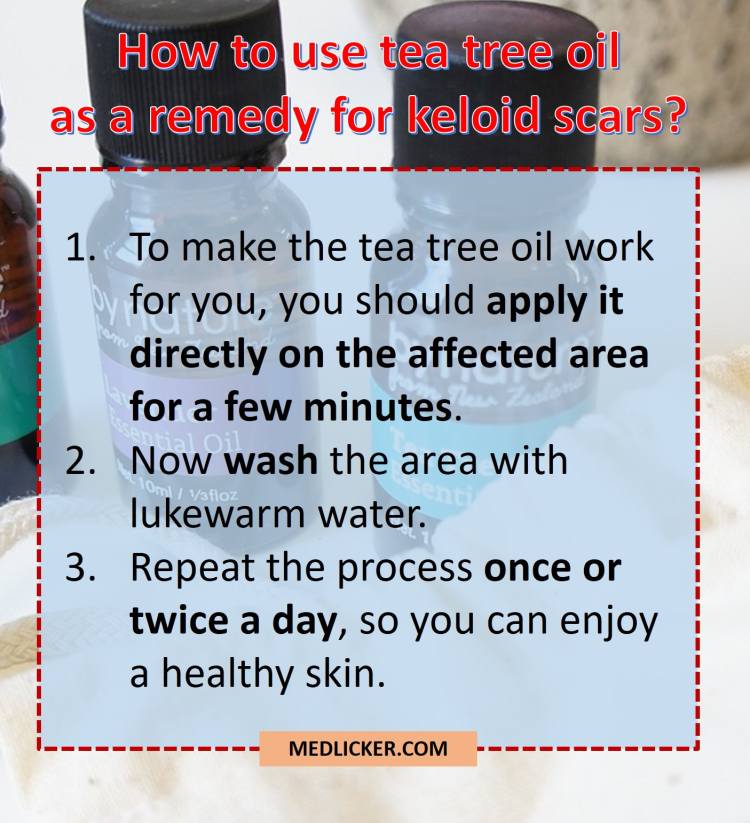
How to use tea trea oil as a remedy for keloids?
It has been used for a long time to treat a number of skin conditions, including keloids.
Directions
To make the tea tree oil work for you, you should apply it directly on the affected area for a few minutes.
Now wash the area with water.
Repeat the process once or twice daily, so you can enjoy a healthy skin.
Onion
You would be surprised to know that one of the most essential ingredients for home cooked meals, onions, is quite beneficial in getting rid of keloid scars. This is due to the fact that onion scars have antibacterial properties which stop the keloid scars from spreading and prevent its appearance.
Research also supports that onion extract is quite beneficial in treating keloids (25).
Directions
To get this remedy right, you will need a blender. So, take an onion and get its juice out with this appliance.
Now take a clean washcloth and place it in onion juice, thus allowing the fabric to absorb it.
Now gently dab it on the keloid scar three times a day until you start seeing results.
Silicone gel sheeting
This treatment is one of the best ways to get rid of keloids that every person should know, especially those suffering from skin issues (26).
The main reason is that it can help to fade away all the traces from scarring. It is usually done in a clinical setting but some people also do it at home. Silicone gel sheets are applied on the skin to moisturize the scar and even change the skin tone to match the skin around the scar. It is nearly invisible in the dry form, so it is quite useful.
The silicone sheets are mainly mineral-based gel membranes, made from medical grade polymers. They are quite smooth, so they can be worn more easily and comfortably. They can easily cover your scar and applying pressure and moisture can easily penetrate them. The best benefit of this treatment is that it has low risks and doesn’t lead to any further damage of the skin tissues. These sheets must be worn for about half an hour for 8 to 10 weeks.
Vitamin E
Vitamin E is one of the essential vitamins for maintaining healthy skin (27). It may actually relieve the visibility of the scars and eliminate them altogether.
It is a fat soluble antioxidant and can be taken with foods, as a capsule (supplement) and/or applied directly to the skin.
You should add all kinds of lotions, supplements, and foods, like almonds and hazelnuts, which increase the vitamin E content in the body.
Directions
Puncture 1 vitamin E capsule and get its right contents to apply on the keloid scars.
Follow a healthy diet plan (eat foods rich in vitamin E such as hazelnuts or almonds).
Emu oil
Emu oil is from the fat from emu bird’s back. It is quite popularly known to reduce inflammation and kill bacteria (28, 29). It is also rich in omega 3 fatty acids which helps in keeping the skin healthy and deeply moisturize and penetrate, so it can be quite effective in treating the appearance of the scars.
Directions
To use emu oil for treating keloids, just take a cotton piece and dab it in emu oil.
Now apply it directly on the scars. In order to see some results, use this method once a day.
Precautions
Till now, it has been an established fact that keloids aren’t only harmful to a person’s physical health, they also pose a threat to the aesthetic beauty of the skin.
So, you should try your best to prevent keloids in the first place.
Here are some precautionary measures to get rid of keloids:
Know the risk factors of keloid formation
The first step in avoiding keloids is to know its major risk factors.
These scars are commonly found on the arm, upper chest and upper back.
They can grow beyond the original wound and can become quite red in appearance. You should also keep the following two things in mind regarding keloids:
- People with darker skin, teens, individuals under 30 and pregnant women are more prone to keloids formation.
- Keloid scars are quite difficult to treat but early recognition can lead to their prevention.
Talk to a healthcare professional
The next thing you need to do is to talk to a healthcare professional. Discuss your family history and mention any previous problems you have regarding skin damage. If you develop a thick and enlarged scar, this indicates that you are more likely to get keloid scar. The Keloid is a growth of accumulated collagen but it can extend out of the healing area.
Get stitches if required
Cuts spread apart or deep ones often heal quickly when they are stitched by a medical professional. However, you should get the wound stitched as soon as possible, preferably when it is fresh. If too much time passes, the doctor may not be able to stitch the wound without the threat of infection. Sometimes, the wound can also heal partially which can be a problem in suturing. If you are in doubt whether stitches are in order, see the doctor and let him decide the best treatment for you.
Don’t fall for false advertising
You might have heard that Vitamin E can reduce scarring, but this hasn’t been proven in a high quality study. As a matter of fact, no over-the-counter product claiming to prevent scars has shown to improve the scars.
Take hyaluronic acid
Hyaluronic acid is a popular supplement present in the body as a diet supplement. Davison, a popular researcher in this field, noted that, in the places where keloid scars have been formed, there is reduced amount of hyaluronic acid (30).
So, you should supplement your diet with hyaluronic acid. However, you should discuss it with your pediatrician if you are planning to take it after pregnancy or you are breastfeeding.
Try cryotherapy
Research has shown that cryotherapy can reduce the thickness of scar by 58%. The earlier the treatment, the better the results. Cryotherapy is usually performed in the physician office using medical instruments to instantly freeze the tissue. However, cryotherapy should be done carefully because it can lead to more scar formation and damage to the nearby tissues if done improperly. When cryotherapy is used to treat a keloid tissue, further preventive measures are required (31).
Discuss surgical options
When all else fails and you have keloid scars that just won’t go away, you should always turn to the method of surgery. Surgery, by itself, can create many scars, however, when performed with a variety other treatments, it can reduce the overall scarring. Once the surgical wounds have healed, you should discuss using silicone gel sheets to reduce the scar formation.
Other than the above mentioned precautionary measures, some doctors also prescribe topical mytomycin C. However, research has shown that it makes no difference to the keloid recurrence.
FAQs about keloids
Here are some frequently asked questions about keloids:
What is a keloid scar?
Sometimes after a cut heals, it leaves behind a raised scar, which can even grow larger than the original wound. Initially, it is red but it darkens over time. They are common all over the body, particularly in the upper chest and ear lobes. They are quite common in the areas of skin tension, like the chest and shoulders. However, they are also found in other areas too.
Who gets keloid scarring?
Keloid scarring can happen to anyone. However, it is commonly found in people with darker skin, especially black skin. Keloid also runs in families. So, prevention is quite important if it runs in families. The scarring is quite common in ages between 10 and 30 years.
Why do people get keloid scars?
It isn’t yet known why some people get keloid scars whereas others don’t. However, there are several theories, like collagen abnormalities, sebum immune reaction and dysfunction of the body part which affects cell growth.
Do I have a keloid or hypertrophic scar?
Contrary to the popular belief, keloid scars are quite different from hypertrophic scars. Keloid scars can occur quite easily, can form an acne spot and develop further from the original wound. They can also be permanent. On the other hand, hypertrophic scars lessen and disappear with the passage of time.
Is ear piercing a common cause of keloid scarring?
Ear piercing is one of the most common causes of keloid scarring. Piercing causes skin trauma which leads to keloid scarring. Keloids can also form from minor injuries with body piercings. The medical world isn’t yet clear why some people are more prone to keloid scarring than others, so, it is impossible to predict whether piercing will lead to keloid scarring in one person and not another one.
How can a person avoid keloid scarring?
If you seriously want to avoid keloid scarring, first of all, never get body piercing and tattoos. You should also avoid cosmetic skin treatments unless backed up by enough evidence. You should also beware of acne and treat it as soon as possible.
Things to remember
By now, you should know all the essential things about keloid scars. These scars are usually formed after the healing of a wound and can grow away from the wound. Although the exact cause of keloid scars isn’t yet known, cut from trauma and infection are the chief causes. There are also many symptoms of keloids, like they are raised, smooth and shiny. They are also raised and dark in appearance.
Keloids can be quite dangerous and they can even be life-threatening.
There are two kinds of treatments of keloid scars.
The first one is the medical treatment, which includes laser therapy and the occlusive dressing. You should also take medical drugs like triamcinolone, clinacort, and kenalog, etc.
On the other hand, there are also some natural treatments, which include the use of everyday foods and items, such as garlic, onion, tea tree oil, lavender oil, honey and lemon juice.
While natural treatments may sometimes work better than medical treatments you should only use them with prior consent of your doctor as there are some risks associated with their use and only a qualified doctor will be able to give you the correct information. Also there is very little evidence concerning home remedies for keloids so use them at your own risk.
Lastly, there are also some precautionary measures which you need to follow, like talking to a healthcare professional, getting stitches, taking cryotherapy and avoiding false advertising.
| Written by: | Michal Vilímovský (EN) |
|---|---|
| Education: | Physician |
| Article resources: | See numbered references in the article. |
| Image resources: | Adobe Stock and Shutterstock |
| Published: | November 23, 2016 at 7:33 AM |
| Next scheduled update: | November 23, 2018 at 7:33 AM |
Get more articles like this in your inbox
Sign up for our daily mail and get the best evidence based health, nutrition and beauty articles on the web.

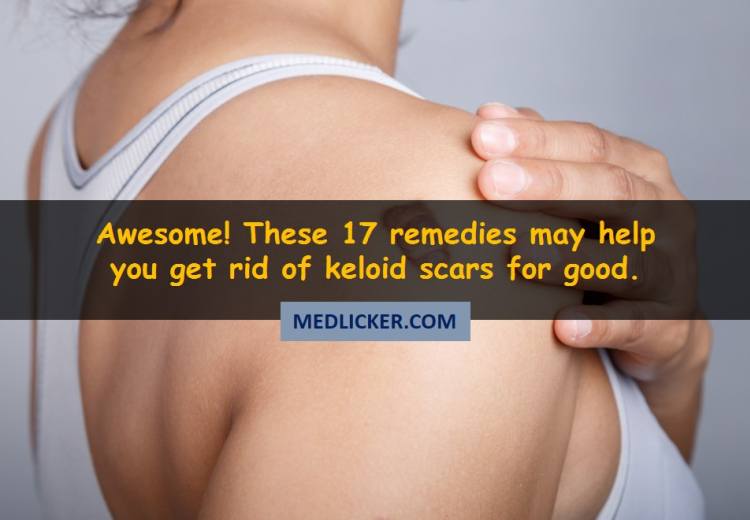
Ache in left arm that you should not ignore
Alkaline water dangers: why you should not drink it
How to Avoid Sleepiness While Studying?
23 Foods That Increase Leptin Sensitivity
Low dopamine (e.g. dopamine deficiency): causes, symptoms, diagnosis and treatment options
Swollen taste buds: the ultimate guide to causes, symptoms and treatment
Thin endometrial lining: causes, symptoms, diagnosis and treatment
Pimples inside nose: the complete guide
Holes in tonsils: definition, symptoms, treatment and prevention
How to deal with an ingrown hair cyst
Allegra vs. Zyrtec vs. Claritin
Allergy to penicillin and alternative antibiotics
How to get rid of phlegm (excessive mucus) in throat? Detailed guide to medical and home remedies, symptoms and causes
What causes stomach ache after meals?
Liver blood test results explained